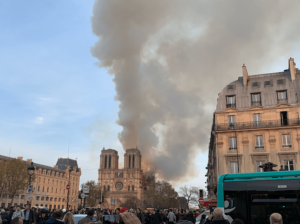by The Cowl Editor on May 2, 2019
Opinion

by Hannah Paxton ’19
Opinion Editor
In light of recent tragedies, like the burning of the Notre-Dame de Paris Cathedral and the attacks in Sri Lanka that occured on Easter, it is interesting to see what types of events elicit a reaction from the world, especially from those who have the resources to evoke change.
On April 15, the roof of the Notre-Dame caught fire, and the world was watching. It was plastered on every screen, every news channel, and across every platform of social media. Pictures of a beloved church burning shocked and unsettled millions.
In response to this heartbreaking event, donors, led by three of France’s wealthiest families, are prompting fundraising efforts in order to restore the damage, topping $700 million. These wealthy donors pledged within 24 hours of the incident.
Meanwhile, recent assaults on churches and hotels in Sri Lanka on Easter Sunday as well as the Chabad of Poway synagogue in San Diego, California last Saturday, have no reported wealthy donations promised for relief efforts.
Evidently, these events have received ample news coverage and fundraising endeavors, but not to the same scale that the Notre-Dame fire collected, and with such an instantaneous response.
With this in mind, it is worth reflecting on what issues constitute millions of dollars worth of philanthropy. There is no question that the burning of the Notre-Dame is an appalling crisis, and worthy of attention.
Yet incidents like those in Sri Lanka and California happen frequently, almost every day, that do not only affect revered structures, but hundreds, and sometimes thousands of people.
When Notre-Dame was on fire, many rushed to post pictures of their visit to the cathedral from their experiences abroad on Instagram. They remarked on the sadness they felt to see a cherished building become tarnished.
While this is a kind gesture, it does little to directly aid the rebuilding efforts or even call attention to the tragedy. Instead, it appears to be another opportunity to showcase one’s time abroad.
Similarly, many posted on Instagram photos from spring break or study abroad photos on Earth Day, commenting on the beauty that the world has to offer. Rarely did these photos provide any insight into how we can help protect the planet.
In the age of social media, it is easy to get carried away with what we post, as we are presenting ourselves to the world.
However, when it comes to vital issues that affect human life, we should all make an effort to use these platforms, and whatever resources we have, to save lives.
As college students, potentially with thousands of dollars of debt, it might be difficult for us to lend a hand in aiding relief to places like Sri Lanka and California. But as avid users of social media, we should take advantage of the wide audience to help spread awareness about these issues.
If we care about people and the Earth as much as we claim to on Instagram, then that devotion should be channeled into productive solutions.